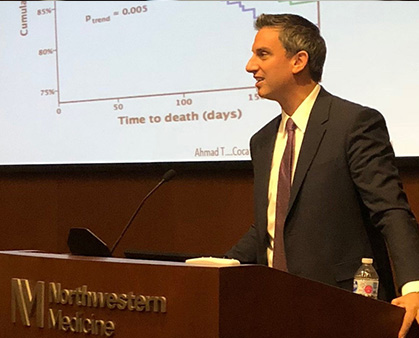6 Tipping Point Innovations in Kidney Care: A Leading Expert Shares His POV
By Elise Wilfinger
06.29.2021

tip·ping point
noun
def:
the point at which an idea crosses a certain threshold and gains significant momentum.
Introduction
Improvements in the standard of care for kidney disease have been relatively slow. That said, certain critical advancements in the last twenty years have served as tipping points in this field, helping to establish a strong foundation for future innovations in kidney care.
Below I share Steve Coca’s (DO, MS) perspective on this topic, featuring the six tipping points he believes have stood out in the last two decades. Steve is an Associate Professor of Medicine (Nephrology) and an Associate Chair for Clinical and Translational Research in the Department of Internal Medicine at the Icahn School of Medicine at Mount Sinai. He is also a co-founder at Renalytix.
-
And first there was…clarity in definition, classification & clinical guidance.
Before:
In 2001, the healthcare system and, most physicians, were still using various and inconsistent terms to describe the different kinds of kidney disease. Further, there were no accepted ways for classifying the different stages of kidney disease nor guidelines for how to action forward depending on patient diagnosis or prognosis.
Tipping Point:
In 2002, the above shortcomings were more widely recognized and acknowledged as consequential. And actions1 were finally taken:
- A universal name was given to this worldwide public health problem:
Chronic Kidney Disease (CKD). And CKD was defined as kidney damage with a glomerular filtration rate (GFR) <60 mL/min/1.73 m2 for 3+ months (which could be identified via a simple patient blood test). - According to the level of GFR, the severity of each patient’s kidney disease could be classified into one of five distinct stages.
- Clinical practice guidelines were developed to ensure consistency in care across PCPs and nephrologists.
In February of that year, the Kidney Disease Outcomes Quality Initiative (K/DOQI) of the National Kidney Foundation (NKF) published 15 clinical practice guidelines on chronic kidney disease2. The guidelines were the first to reflect the science and evidence-based strategies for prevention, detection, evaluation, and treatment of CKD. Over time, the guidelines have been refined, updated and published by the international group of experts known as KDIGO (Kidney Disease Improving Global Outcomes)3.
- A universal name was given to this worldwide public health problem:
-
A difference-making, genetics discovery.
Before:
It had been known for years that African-Americans and Hispanics were at higher risk for kidney failure. However, there was debate regarding whether certain genetic or inherited factors accounted for the tangible racial differences in kidney disease.
Tipping Point:
In 2010, scientists found that variants in the APOL1 gene explained a large fraction of this major health disparity, where significant increases in the risk for kidney failure existed.4 It was determined that large fractions of patients who reached kidney failure were most likely due to the APOL1 gene vs the presumption of chronic hypertension (characterized by persistent elevation in blood pressure)5.In the future, these findings may help clinicians make more informed choices about:
- When to start screening for kidney disease
- How to choose an appropriate therapy by identifying which patients have these gene variants
- Identify those with increased risk of developing kidney disease and progressing to kidney failure
-
Non-invasive biomarkers enter the picture.
Before:
Kidney failure is, both in the acute (hospitalized) and chronic (outpatient) settings, largely determined by the degree of function, and historically measured by serum creatinine in blood or urine. However, the elevations in serum creatinine do not help distinguish between different aetiopathological (cause of disease) processes, nor do they accurately reflect ongoing histopathological (cellular changes) characteristics. The reliance on these traditional measurements has limited the ability for early, timely, and targeted innovations.
Tipping Point:
There is now extensive data on various new markers in the blood and urine that can determine the etiology of kidney disease6, diagnose kidney damage earlier7, and/or help prognosticate risk for kidney disease progression8.
The hope is that earlier assessment of this risk will enable more timely, appropriate, and effective therapies in the prevention and treatment for the disease, which can significantly improve patient outcomes and reduce the enormous costs associated with kidney disease today.
-
The insights that only Single Cell Technologies can help unearth.
Before:
Traditionally, bulk RNA sequencing allowed scientists to look at millions of cells at once, enabling a measured expression of the average of those combined cells. One was unable to study the transcriptome at the single cell level, where each cell is isolated with the ability to study and compare one cell to another.
Tipping Point:
Now we benefit from the development of single cell sequencing, where scientists can take a single cell and sequence its genetic information. The RNAs expressed by these single cells give insight into the existence and behavior of various cell types.
As it relates to improving kidney health, scientists have needed a better understanding of the following5:
- The highly complex tissue found in the kidneys
- The broad range of kidney cell types and how they’re organized into
distinct compartments - How does each compartment include different kidney cell functions?
- How do regulatory mechanisms (cellular controls) underpin cell behavior?
Single-cell RNA sequencing provides such insight and holds great promise in enabling the development of better diagnostic tools, predictive biomarkers and signaling pathways for new drug discovery and therapeutic targeting.
-
And then, some game-changing therapeutics came to market.
Before:
Treatments for diabetic kidney disease (DKD) were largely limited to a class of drugs called angiotensin converting enzyme inhibitors (ACEi) or angiotensin receptor blockers (ARBs). The protective effect of these drugs was insufficient, and significant progression still occurred in the clinical trials and in clinical practice.
Several novel therapeutics from pharma, including Ruboxistaurin, Avosentan, Pirfenidone, Sulodexide, Aliskerin, Bardoxolone methyl, and others, were studied for DKD over the past 20 years. Each failed to improve outcomes.
Tipping Point:
SGLT2 inhibitors were initially introduced in 2013, with the goal of lowering blood sugar in diabetics. These medications prevent the action of proteins called “sodium-glucose cotransporter 2” from reabsorbing sodium and glucose from the urine back into the blood. Instead, they cause the kidneys to dump the glucose and sodium back into the urine.
Serendipitously, large scale clinical trials have demonstrated that SGLT2i not only reduces blood glucose, but achieves what many of the previously listed agents failed to do: robustly ameliorate the progression of kidney disease by 25-40%.9
Moreover, they reduce the risk of cardiovascular events, heart failure, and death. These drugs are clearly game-changing, and new data continues to emerge on how they act through the kidney and how they may yield benefits throughout the body and across organ systems.9
-
Finally, the government took notice…and acted.
Before:
1 in 7 adults in the U.S. live with chronic kidney disease. For patients in kidney failure, the only options are dialysis or transplant. Dialysis takes a severe toll on both patients and on the Medicare system, which is hit with a corresponding $114 billion dollar price tag each year. Even with these statistics, little had been done at the federal level to course-correct.
Tipping Point:
Three significant public policy measures have moved the needle on kidney care in the U.S.:
- The Kidney Health Initiative A public-private partnership between the American Society of Nephrology and the US Food and Drug Administration (FDA) whose stated mission is to catalyze innovation and the development of safe and effective patient-centered therapies for people living with kidney diseases. Importantly, it removes typical obstacles for bringing new drug and biologic innovations to market.
- KidneyX Building off the success of similar public-private accelerators, like the above, KidneyX was created to engage a community of researchers, innovators, and investors to bring moonshot thinking and breakthrough therapies to patients. It specifically engages through development (access to disruptive technologies via competitive funding to innovators), coordination (of relevant agencies), and urgency (fast-tracking).
- 2019’s Advancing Kidney Care Health Executive Order This bold new initiative, which also seeks to improve patient lives by accelerating the development of drugs, devices, and other therapies, also removes pre-existing, regulatory and reimbursement barriers. Innovation has been sparked from within and outside of the government, with an eye toward a comprehensive solution to this significant health crisis of kidney disease.
Tipping Points… Forward
Exciting new advancements and innovations in kidney care are on the horizon, from portable and wearable dialysis machines to artificial kidneys that are implanted in the body.
There is also growing sentiment for shifting our thinking from downstream innovation and kidney disease care improvements toward kidney health and early-stage progression risk assessment to better head off kidney disease, when it counts the most.
In addition to the Administration, many health organizations have pledged their support to innovate in this field. One shining example is the American Association of Kidney Patients and AAKP’s Decade of the Kidney™, a strategic ten-year global innovation and collaborative initiative announced upon the signing of the Executive Order on Advancing American Kidney Health last year.
If you enjoyed this post, we’d be grateful if you would help us spread its content.

